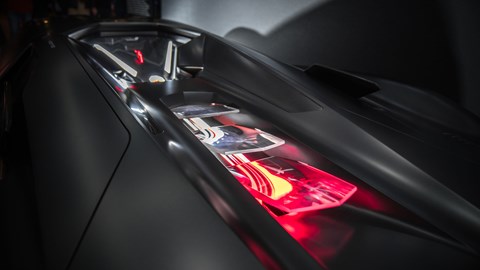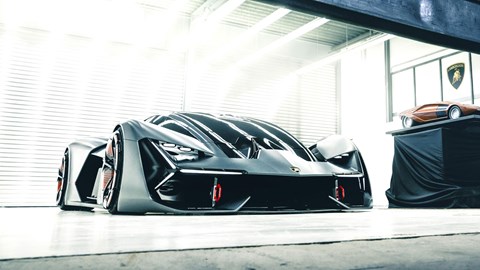► Supercapacitors have several benefits over batteries
► But currently a few drawbacks too
► They’re used in the new Lamborghini Sian
In 2019, electric cars are widely seen as the successor to ICE vehicles, and manufacturers are rushing to electrify their model line-ups: the 2019 Frankfurt motor show will see production-ready EVs from Porsche, VW and Honda to name a few. And it’s easy to see why.
Better range, more charging points, and general refinements across the board now make electric vehicles a serious contender to petrol counterparts. But they’re still far from perfect for many, taking time to charge and still lacking truly widespread infrastructure, in the UK at least.
Although it’s the default now, lithium-ion technology may not be the final answer when it comes to powering EVs. Supercapacitors provide solutions to some lingering problems with battery powered all-electric cars – and have added benefits for hybrids, too. They could be the jolt the EV world needs, but what are supercapacitors, how do they work and are they as sci-fi as they sound?
What is a supercapacitor?
Let’s first explain what a supercapacitor is. Sometimes called an ultracapacitor, a supercapacitor – like a battery – is a means to store and release electricity. But rather than storing energy in the form of chemicals, supercapacitors store electricity in a static state, making them better at rapidly charging and discharging energy.
To the chemistry lab!
Lithium-ion batteries work by using layers of cells with using positive and negative electrodes separated by an electrolyte. They generate a charge as lithium ions move from negative to positive when discharging, and the reverse happens when charging.
How do supercapacitors work?
Capacitors, on the other hand, store electricity in a static state, rather than leaving it ‘locked up’ in chemical reactions. Crack open a capacitor and you’ll find two conducting plates, called electrodes, separated by an insulating material known as a dielectric. These two plates, one positive and the other negative, generate an electrical field when connected to an electric circuit, which polarises the atoms in the dielectric so the positive atoms sit on the side of the negative plate and negative atoms on the side of a positive plate, thus creating a charge.

In many ways, a supercapacitor is simply a larger capacitor with bigger electrode plates and less distance between them, allowing for a greater charge to be stored in the form of electrical potential energy. A supercapacitor doesn’t use a dielectric; instead porous electrode plates are soaked in an electrolyte and separated by a very thin separator material. When a charge is passed through the electrodes, the atoms in them become polarised – giving the electrodes a positive or negative charge.
These then attract electrons of the opposite polarity in the electrolyte, and thus create a double electric layer, meaning supercapacitors store a lot more power than their regular capacitor counterparts.
What are the advantages of supercapacitors?
Supercapacitors already exist in cars with regenerative braking systems. This is thanks to their greater power density than chemical reaction-based batteries, which allows them to rapidly store and discharge electricity, handy for collecting energy generated under braking then quickly releasing it upon acceleration.
Full cell-based cars, like the Toyota FCHV, also use supercapacitors to deliver auxiliary accelerative power that hydrogen fuel-cells struggle to do alone.
They’ve yet to take over from lithium-ion batteries as the primary power source, but electric and hybrid vehicles are advancing year on year, so there’s a lot of potential for supercapacitors to play a bigger role in next-generation electric cars and charging infrastructure to support them.
As supercapacitors pretty much rely on physics rather than chemistry to store their energy, they don’t degrade in the same fashion as lithium-ion batteries. That could present a huge opportunity in improving the lifespan of an electric car, as well as reducing the environmental impact of using lithium-ion power cells.
But the largest advantage of supercapacitors over lithium-ion and nickel cadmium batteries is their ability to charge and discharge rapidly; we’re talking charging in minutes rather than hours. So supercapacitors could be the panacea to reduce the hours it currently takes to recharge an all-electric car – or offer a boost of speed to hybrids, something we’ll explain later in this article.
Supercapacitors also handle wireless charging very well, which when combined with their ability to charge at speed, could remove the need to plug EVs into powerpoints and make charging a more seamless process.
What are the disadvantages of supercapacitors?
There are two main issues with supercapacitors right now, and the most alarming is energy density. Sure, supercapacitors can absorb and deliver a large amount of power, faster than lithium-ion batteries – but right now, they aren’t able to store as much.
It’s an issue that makes them less suitable for electric cars as things stand, but doesn’t mean they should be ruled out in the future. Don’t forget it took a while to extract an acceptable mileage range out of lithium-ion battery systems, so there are opportunities for the energy density of supercapacitors to be improved by the clever folk working away on improving their efficiency.
Researchers from the University of Surrey have claimed a breakthrough in materials for supercapacitors that could enable them to have the range of petrol cars, but it’s early days and you won’t see that from current supercapacitors.
The second issue with supercapacitors as they stand is discharging, or the amount of time they’re able to hold a charge for. Currently, supercapacitors can’t hold a charge as long as a lithium-ion battery. If you left a supercapacitor-powered car in the garage for a week, for example, you’d likely find it with no charge when you returned.
Rapid charging could solve this problem, but you’d need to make sure you have a charger handy, and one that has enough amperage to deliver the high charge a supercapacitor can handle. You’re not likely to have a home charger that comes with a couple of thousand amps to spare.
Inevitably, as breakthroughs are made in supercapacitors, we can expect better energy storage and ways to prevent rapid discharging emerging, which could eventually lead to supercapacitors superseding lithium-ion battery systems. But that’s looking to be a way off.
Supercapacitors right now? A helping hand for hybrids
Inevitably, as breakthroughs are made in supercapacitors, we can expect better energy storage and ways to prevent rapid discharging emerging, which could eventually lead to supercapacitors superseding lithium-ion battery systems. But that’s looking to be a way off.
So what about now? While supercapacitors may not be seen in EVs for a while, the technology already fits perfectly into hybrid powertrains. Supercapacitors are already used to rapidly charge the power supplies in hybrid buses as they go from stop to stop – but car makers such as Lamborghini are finding they can also add some serious extra performance, too.
When hybrid energy is used purely for performance, issues such as range and the ability to hold charge aren’t as important – and that’s why we’re already seeing the technology creep into the hypercar world.
The Lamborghini Sian combines a supercapacitor-powered 34bhp e-motor in conjunction with a Sant’Agata V12, for sub 3.0sec 0-62mph performance.
In the Sian, the use of a supercapacitor is the sole method of electric power storage, but it’s possible we could get vehicles that mix supercapacitor and lithium-ion tech, too – harnessing the benefits of both; lithium-ion batteries would still the main source of power, but supercapacitors could augment them for faster energy discharge and recharge during accelerating and braking.

What’s the future for supercapacitors?
We’re just spit-balling an idea here, but such a car could run on supercapacitor power around town where there is the infrastructure to support rapid charging, effectively hopping from powerpoint to powerpoint. Then, for longer jaunts, the car could switch over to the lithium-ion battery with regenerative braking helping eke out more range.
Given Tesla bought Maxwell, a specialist in supercapacitors and batteries, in 2019, there’s a chance it could be the car maker to make such an electric car a reality; time will tell on what Tesla uses Maxwell’s tech for.
Supercapacitors are already used to rapidly charge the power supplies in hybrid buses as they go from stop to stop. Currently, such chargers aren’t commercially viable to deliver on a mass scale, but as more people buy electric cars the charging infrastructure is likely to develop to a point that widespread supercapacitor chargers become a reality.
So we can expect to see supercapacitor charging points and wireless charging pads powered by them at stations, like the electrical equivalent of a petrol pump able to fill up a car in minutes.
To get a little sci-fi on things, such charging could be extended further with supercapacitors built into roads constantly delivering power to electric cars as they zip along and pause at traffic lights. Outside of dedicated lanes on motorways, such a vision might seem a little far-fetched.
But electric car systems, batteries, charging and tech are improving all the time, so the scope for supercapacitors to amp up future EVs is electrifying.